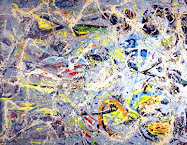"Know yourself. Don't accept your dog's admiration as conclusive evidence that you are wonderful."
Ann Landers.
Self Understanding is imperative to the risk-taker. Often, I look to my days as a rock climber for analogies to explain something. When I did the daredevil sport, and it came time to try the next harder grade, it was only when I could do a thorough self-diagnostic that I knew I was ready to advance. Energy? Check. Fitness level? Check. Equipment? Check. Weather? Maybe, well okay-check.
The artist may advance his images with greater confidence if he knows what his limits and abilities are. When you began the painting, you were envisioning a Michelangelo. In the end, for some reason, it turned out as a Klahn. Not that it's bad, but still not what you envisioned!
"Trust not yourself,
but your defects to know;
make use of every friend
and every foe."
Alexander Pope.
Do I mean introspection? Navel-gazing? Not too much. We are not writing philosophy; we are making pictures. Wasn't it Oscar Wilde who said, "...the shallow know themselves"? But, a little self-awareness of, for instance, the will to finish a particular painting might be good to have. You may ask yourself, "Do I care enough about trees-in-a-glen to make this image really speak?"
Some self understanding will keep you against that day when the nay-sayers come about and denounce your work. "If I ever decide to buy something like that, stop me!" "Everyone can't be Rembrandt!" "Art is okay for you, if you can make a living at it!"

Why do you make this art? Are you strong in yourself? Do you feel the art in your bones? It might be good to know the why of it for when that day of doubt arrives.
"To reach any knowledge of oneself is a rare and precious bonus. Most people live to the end in doubt and uncertainty. What a torment! It's not a matter of finding the right path, but of finding one's own path, as Nietzsche said, 'Become who you are.' Alas! for [sic] one moment of certainty, how many hours of doubt!" Henri Edmund Cross
I think that having a solid "first person authority," knowing what you think, understand and believe, can help in making your art unique and authentic. It is one piece of the originality puzzle that all artists seek to solve.
Have you ever had the experience of revisiting a painting that you haven't looked at for a while, and discovering that it has a trace of van Gogh in it? You didn't know you had that in you, and you are wondering how that happened. There is no end to the delight of self discovery through art.
"I know...that I myself have no special talent; curiosity, obsession and dogged endurance, combined with self-criticism, have brought me to my ideas," Albert Einstein.
Another common phrase for the self-seeker is "Don't fool yourself". Once in a while, use some tools for checking in on your own ideas and beliefs about yourself. Sometimes, the mirror is a good device, and sometimes it is the mirror of a friend that tells the truth.
Have you ever overheard others speaking well of you? I hope you get the chance, as it is a wonderful thing to hear un-solicited praise. And, at the same time, the truth can be helpful when it's not exactly praise.
Another fun example of third party input is to secretly observe people looking at your art. I once posted some cartoons on a bulletin board, and a friend of mine made sure that I stood ten feet away and watched reactions. Didn't Mark Tobey make a point of going to his own openings in disguise?
Next Post: I'll be asking you to add your traits-to-be-gained. What are your desired traits for the artist's life?
References:
Stanford on Self Knowledge.
Extreme self-thought.




























